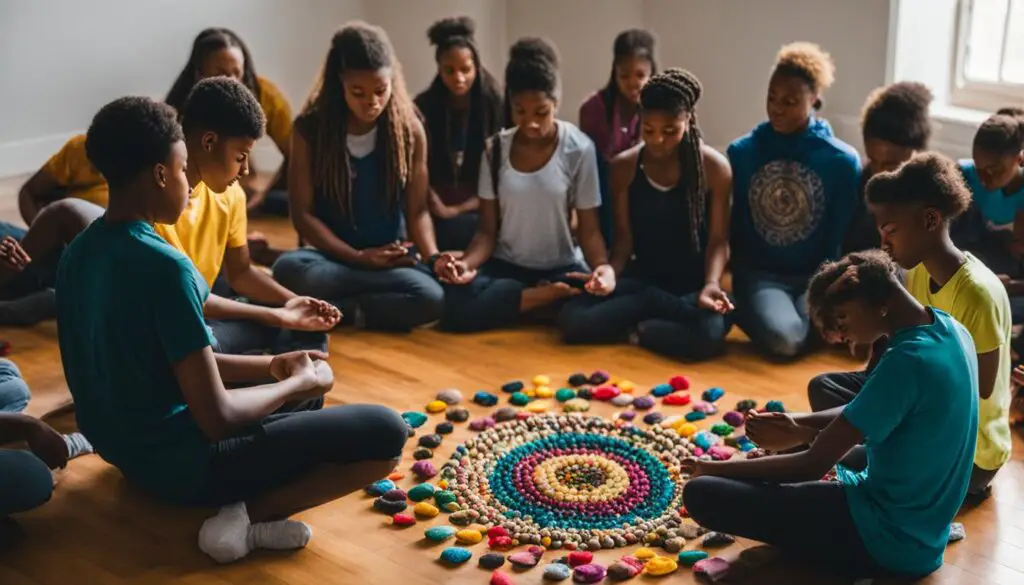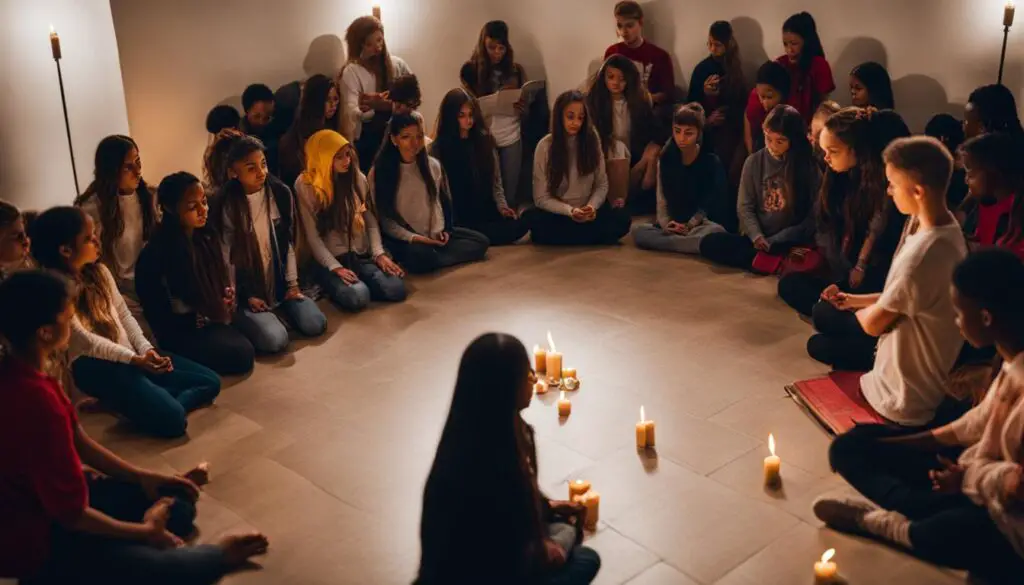Welcome to a transformative journey of prayer for today’s teenagers. In this engaging youth group lesson, we will explore the power and significance of prayer in a way that will inspire and deepen the spiritual connection of young hearts. Our aim is to equip teens in the United States with the tools and understanding they need to make prayer a vital part of their relationship with Jesus Christ.
Key Takeaways:
- Youth prayer lessons have the potential to inspire and transform the lives of teenagers.
- Teaching youth about prayer is essential in helping them develop a personal connection with God.
- Prayer can be a powerful tool in navigating the challenges of life and seeking guidance.
- Engaging and interactive prayer lessons can help youth understand the significance and benefits of prayer.
- By making prayer a priority, teens can experience the transformative power of conversation with God.
The Importance of Prayer
Prayer is a vital aspect of developing faith and strengthening one’s relationship with God. It serves as a means for individuals to communicate with God, seek His guidance, and experience His presence in their lives. Teaching youth about the importance of prayer is essential in helping them grow spiritually and navigate the challenges of life.
One of the key benefits of prayer is its ability to deepen one’s personal connection with God. Through prayer, young people can express their thoughts, feelings, and desires to God, fostering a sense of intimacy and trust in their relationship. Additionally, prayer helps individuals understand the nature of God and His unconditional love for them, which in turn enables them to rely on Him for guidance and support.
Furthermore, prayer provides direction and clarity amidst the uncertainties of life. It helps young people find purpose and meaning, as they seek God’s will and align their own desires with His. By turning to prayer, teenagers can overcome temptations, make wise decisions, and navigate through various challenges they face on a daily basis.
Moreover, prayer invites the Holy Spirit into one’s life, allowing for transformation and spiritual growth. It opens the door for God to work miracles and bring about positive change. By teaching youth about prayer, we equip them with a powerful tool that can bring healing, forgiveness, and guidance into their lives.

What is Prayer and Why is it Important?
Prayer is a powerful means of communication with God, allowing individuals to express their deepest thoughts, desires, and emotions. It is a solemn request for help, an expression of gratitude, and a way to seek guidance and understanding from a higher power. Prayer holds immense significance in the lives of believers, providing a channel for connection and reflection. By teaching youth about prayer and sharing creative prayer ideas, we can inspire them to experience the transformative power of prayer in their own lives.
Prayer serves multiple purposes. It allows individuals to establish a personal relationship with God, fostering a sense of intimacy and reliance. Through prayer, we can seek healing, mercy, forgiveness, wisdom, and guidance, recognizing that God is a loving and compassionate Father who desires to be in communion with His children. By engaging in prayer, young people can develop a deeper understanding of God’s nature and experience His presence in their lives.
Prayer is not only a one-way conversation, but it also enables individuals to listen to God’s voice and receive answers to their prayers. It is a dynamic and interactive process that involves both speaking and listening. By teaching youth about prayer and encouraging them to explore the different types of prayers, such as petitionary, intercessory, contemplative, confessional, and listening prayers, they can discover various ways to engage with God and grow in their faith.
| Benefits of Teaching Youth About Prayer: |
|---|
| 1. Deepens their relationship with God |
| 2. Provides a source of comfort, guidance, and support in their lives |
| 3. Fosters a sense of connection and community with other believers |
| 4. Enhances their spiritual growth and personal reflection |
| 5. Promotes emotional well-being, gratitude, and positivity |
By equipping young people with the knowledge and understanding of prayer, we empower them to navigate life’s challenges with faith and resilience. Creative prayer ideas and interactive prayer experiences can make the practice of prayer more engaging and relatable for youth, encouraging them to make prayer an integral part of their spiritual journey. As we guide them in discovering the power and importance of prayer, we enable them to experience its transformative impact and draw closer to God.
Quotes:
“Prayer is not asking. It is a longing of the soul. It is daily admission of one’s weakness. It is better in prayer to have a heart without words than words without a heart.” – Mahatma Gandhi
“Prayer is not asking. Prayer is putting oneself in the hands of God, at His disposition, and listening to His voice in the depth of our hearts.” – Mother Teresa
Benefits of Praying for Youth
Praying offers numerous benefits for young people, promoting their overall well-being and personal growth. By engaging in prayer, youth can develop emotional stability, enhance their focus and concentration, and build a sense of connection and community. Prayer also serves as a healthy coping mechanism, inspiring gratitude and positivity in their lives. Additionally, it cultivates discipline and routine, guides decision-making, and encourages cultural and social understanding.
Emotional Stability and Well-being
Prayer is a powerful tool for improving emotional stability and well-being among youth. It provides a safe space for expressing their emotions, releasing stress and anxiety, and finding comfort and solace in God. Through prayer, young people can experience a sense of peace and calm that positively impacts their mental and emotional health.
Connection and Community
Prayer helps youth foster a sense of connection and community. By praying together in youth group settings or participating in prayer activities, young people can develop deep bonds with their peers, mentors, and God. This sense of connection provides a support network and a sense of belonging, which is essential for their overall well-being and personal growth.
Discipline and Routine
Engaging in regular prayer cultivates discipline and routine in the lives of young people. By setting aside dedicated time for prayer, they learn the importance of prioritizing their relationship with God. This discipline extends beyond prayer and can positively influence other areas of their lives, such as academics, relationships, and personal goals.
Cultural and Social Understanding
Prayer encourages young people to understand and respect diverse cultural and social perspectives. Through prayer, youth can learn about different religious practices and traditions, promoting tolerance and empathy. This understanding can contribute to their personal growth and equip them to navigate an increasingly diverse world.
| Benefits of Praying for Youth |
|---|
| Emotional Stability and Well-being |
| Connection and Community |
| Discipline and Routine |
| Cultural and Social Understanding |
The Different Types of Prayers for Youth Groups
When it comes to youth group prayer ideas, providing a variety of prayer experiences can help engage and inspire young people. By introducing them to different types of prayers, we can encourage creativity, self-reflection, and a deeper connection with God. Here are some of the types of prayers that are suitable for youth groups:
Petitionary Prayers
Petitionary prayers involve asking God for something. This type of prayer allows youth to bring their needs, desires, and concerns before God, seeking His guidance, provision, and intervention.
Intercessory Prayers
Intercessory prayers are when youth pray on behalf of others. This type of prayer encourages empathy and compassion as youth lift up the needs of their friends, family, community, and even global issues to God.
Contemplative Prayers
Contemplative prayers focus on meditation and self-reflection. This type of prayer encourages youth to take moments of stillness and silence to listen to God, reflect on His Word, and deepen their personal relationship with Him.
Confessional and Listening Prayers
Confessional and listening prayers involve confessing sins and seeking guidance from God. This type of prayer allows youth to experience the healing power of confession, receive forgiveness, and seek direction in their lives.
Table:
| Type of Prayer | Description |
|---|---|
| Petitionary Prayers | Asking God for something |
| Intercessory Prayers | Praying on behalf of others |
| Contemplative Prayers | Focusing on meditation and self-reflection |
| Confessional and Listening Prayers | Confessing sins and seeking guidance from God |
By teaching youth about these different types of prayers and providing opportunities to engage in them, we can help them develop a well-rounded and meaningful prayer life. Remember, creativity and variety are key in keeping the youth interested and inspired as they grow in their faith journey.
Ideas for a Lesson on Prayer for Youth
When planning a lesson on prayer for youth, it is essential to make it engaging, interactive, and thought-provoking. By incorporating various activities, discussions, and creative approaches, you can create a memorable experience that helps young people deepen their understanding and practice of prayer. Here are some ideas for a youth prayer lesson plan:
1. Discussing the Basics of Prayer
Start the lesson by discussing the fundamental aspects of prayer, such as what it is, why we pray, and how to pray. Encourage open discussion and provide opportunities for students to share their thoughts, experiences, and questions. This will help create a safe and inclusive environment for exploring their understanding of prayer.
2. Crafting Personal Prayers
Invite the youth to explore their personal prayer styles by encouraging them to create their own prayers. Provide prompts or themes to guide their prayer writing, such as gratitude, forgiveness, or seeking guidance. Afterward, allow students to share their prayers with the group, fostering a sense of community and inspiring others in their prayer journey.
3. Introducing Meditation as a Form of Prayer
Teach the youth about the practice of meditation as a form of prayer. Explain its benefits and demonstrate simple meditation techniques. Create a calming atmosphere by dimming the lights, playing soft instrumental music, and guiding the students through a meditative prayer experience. Encourage them to reflect on the presence of God and listen to His voice.
4. Organizing Community Prayer Gatherings
Plan a collective prayer gathering where the youth can come together as a community to pray for specific needs, such as their schools, families, or global issues. Create prayer stations with different themes or prayer focuses to accommodate diverse spiritual preferences. This activity will foster unity, intercession, and a sense of shared purpose among the youth.
5. Providing Outdoor Prayer Experiences
Take the youth outside for a prayer walk or hike, allowing them to connect with God in nature. Encourage them to observe the beauty around them, reflect on God’s creation, and pray silently or out loud during the outdoor experience. This activity provides a change of environment and stimulates spiritual contemplation.
| Activity | Description |
|---|---|
| Discussing the Basics of Prayer | Engage in a group discussion about what prayer is and its significance. |
| Crafting Personal Prayers | Guide the youth in writing their own prayers on specific themes or topics. |
| Introducing Meditation as a Form of Prayer | Teach the youth about meditation as a way to connect with God and provide a guided meditation experience. |
| Organizing Community Prayer Gatherings | Plan a collective prayer gathering where the youth can intercede for various needs or causes. |
| Providing Outdoor Prayer Experiences | Take the youth outside for a prayer walk or hike, encouraging them to pray in nature. |

Why Prayer Matters
In today’s fast-paced and chaotic world, teaching youth about prayer is more important than ever. Prayer matters because it allows individuals to communicate with God, seek His guidance, and experience His presence in their lives. Prayer is not just a religious practice; it is a powerful tool that can transform lives and bring about positive change.
When we teach youth about prayer, we are helping them tap into a source of strength, comfort, and hope. Prayer equips them to face the challenges and uncertainties of life with a sense of peace and confidence. It teaches them to rely on God and trust in His plan, even when things seem difficult or impossible.
By teaching youth about prayer, we are empowering them to develop a personal relationship with God. Prayer opens the door to a two-way conversation with our Creator, where we can pour out our hearts, express our gratitude, share our fears and doubts, and seek His guidance and wisdom. It is through prayer that young people can experience the unconditional love and acceptance of God.
Prayer is not asking. It is a longing of the soul. It is daily admission of one’s weakness. It is better in prayer to have a heart without words than words without a heart. – Mahatma Gandhi
| Benefits of Teaching Youth About Prayer | Prayer Lessons for Teenagers |
|---|---|
| 1. Develops a deeper connection with God | 1. Encourages personal growth and self-reflection |
| 2. Provides a sense of purpose and guidance | 2. Builds emotional stability and well-being |
| 3. Helps manage stress and anxiety | 3. Fosters gratitude and positivity |
| 4. Promotes empathy and compassion | 4. Cultivates discipline and routine |
| 5. Encourages ethical decision-making | 5. Enhances focus and concentration |
Teaching youth about prayer is not just about imparting knowledge; it is about instilling in them a lifelong practice that will sustain and nourish their faith. It is about showing them that they can always turn to God in times of joy, sorrow, confusion, or need. By empowering young people to embrace prayer, we are equipping them with a powerful tool that will guide and support them throughout their lives.

Praying From A to Z
Prayer is a powerful tool that allows us to communicate with God and seek His guidance and support in all aspects of our lives. When teaching youth about prayer, it’s essential to help them understand that prayer is not limited to a specific topic or situation. In fact, prayer can cover every area of our lives, from A to Z. By encouraging youth to pray from A to Z, we can expand their prayer vocabulary and help them realize that nothing is too big or small to bring to God in prayer.
Praying from A to Z means bringing every concern, request, and thanksgiving to God. From asking for wisdom in academics (A) to seeking strength in difficult times (S), from expressing gratitude for friendships (F) to praying for healing in times of sickness (H), praying from A to Z encourages youth to approach God with all of their needs and desires. It also teaches them that God is interested in every aspect of their lives and desires to be involved in every situation.
When teaching youth about praying from A to Z, it can be helpful to provide them with a visual tool, such as a prayer journal or a prayer wheel. This can serve as a reminder to cover a wide range of topics in their prayers and help them stay focused on their conversations with God. By incorporating this practice into their prayer lives, youth can develop a comprehensive and meaningful prayer life that aligns with God’s will and fosters a deeper relationship with Him.
Benefits of Praying from A to Z
- Encourages a comprehensive prayer life
- Helps youth stay focused in their prayers
- Deepens their relationship with God
- Develops a habit of seeking God’s guidance in all aspects of life
- Fosters a sense of trust and reliance on God
Praying from A to Z is not just about covering a wide range of topics; it’s about inviting God into every area of our lives and acknowledging His sovereignty over all things. By teaching youth this prayer approach, we can empower them to pray boldly, confidently, and expectantly, knowing that God hears and answers their prayers according to His perfect will.
| Benefits of Praying from A to Z | Benefits of Praying from A to Z |
|---|---|
| Encourages a comprehensive prayer life | Helps youth stay focused in their prayers |
| Deepens their relationship with God | Develops a habit of seeking God’s guidance in all aspects of life |
| Fosters a sense of trust and reliance on God | Table finished |

Don’t Just Phone It In
Teaching youth about prayer goes beyond simply going through the motions. It involves guiding them to have deep, intimate conversations with Jesus, their closest friend. By encouraging youth to go beyond surface-level prayers and engage in soul-level chats, we can help them cultivate a more meaningful and transformative prayer life.
Interactive prayer lessons for youth play a crucial role in teaching them the value of authentic connection with God. These lessons can include activities that invite introspection, such as journaling or quiet contemplation, where young people can pour out their hearts to God and listen for His gentle voice. By creating a safe space for vulnerability and openness, we empower youth to experience the fullness of God’s presence in their lives.
One effective way to encourage deep conversations with Jesus is to emphasize the importance of authenticity in prayer. Young people need to know that it’s okay to be honest with God about their doubts, fears, and struggles. Prayer is a safe place to express emotions, ask tough questions, and seek guidance. By teaching youth that they can come to God just as they are, without pretense or masks, we help them develop a genuine and meaningful prayer life.

In conclusion, teaching youth about prayer is about teaching them how to have a personal, transformative relationship with God. By guiding them to go deeper in their conversations with Jesus and emphasizing authenticity, we equip them with the tools to navigate life’s challenges and experience the fullness of God’s love. Through interactive prayer lessons, we can inspire young people to discover the power and joy of a prayerful life.
Prayers of Old Testament Women
Exploring the prayers of Old Testament women can provide valuable insights into developing a prayerful life. These women, such as Miriam, Deborah, Hannah, Esther, and Hagar, exemplify faith, courage, and persistence in their communication with God. By studying their prayers, youth can learn about the different approaches to prayer and the genuine connection they had with God.
One example is Miriam, who praised God in a song of victory after the Israelites safely crossed the Red Sea (Exodus 15:1-21). Her prayer is a beautiful expression of gratitude and trust in God’s power. Deborah, a prophetess and judge, offered a prayer of victory after leading the Israelites to triumph over their enemies (Judges 5:1-31). Her prayer demonstrates a deep reliance on God’s strength and guidance.
Hannah’s heartfelt prayer for a child in 1 Samuel 1:10-20 illustrates her honesty, vulnerability, and willingness to surrender her desires to God. Esther, facing a life-threatening situation, sought God’s intervention through fasting and prayer (Esther 4:15-17). Her prayer showcases her courage and trust in God’s sovereignty. Additionally, Hagar, when faced with distress and abandonment, encountered God in the wilderness and received comfort and assurance (Genesis 16:7-14).
Studying these prayers can inspire youth to approach prayer with authenticity, trust, and a deep desire to connect with God. Youth leaders can incorporate these examples into their interactive prayer lessons for young adults, encouraging them to explore different prayer styles, express their thoughts and emotions, and develop a meaningful prayer life.
Conclusion
Teaching youth about prayer is a vital step in nurturing their spiritual journey and establishing a deep and meaningful relationship with God. By creating engaging and interactive lessons on prayer, youth leaders can inspire young people to make prayer a priority in their lives. These youth group lessons on prayer provide valuable opportunities for teens to explore the power of prayer and its impact on their personal relationship with Jesus Christ.
Prayer offers numerous benefits for young individuals, including emotional stability, moral development, focus and concentration, and a sense of connection and community. By introducing diverse prayer experiences and encouraging youth to engage in various types of prayer, they can truly understand the power and significance of prayer in their lives.
With a comprehensive understanding of prayer and its importance, youth can develop a prayer vocabulary and pray from A to Z, knowing that no prayer is too big or small for God. By going beyond surface-level conversations and fostering intimacy in their prayer life, youth can experience a transformative connection with Jesus, their ever-present friend. Furthermore, exploring the prayers of Old Testament women provides valuable insights into approaching God in prayer and deepening their conversation with Him.
Teaching youth about prayer is not only about imparting knowledge but also about inspiring them to cultivate a personal and vibrant prayer life. These youth prayer lessons empower young individuals to connect with God in their unique ways and embrace prayer as a powerful tool for spiritual growth and guidance.
FAQ
What is the importance of teaching youth about prayer?
Teaching youth about prayer is essential in helping them grow spiritually and navigate the challenges of life.
What is prayer and why is it important?
Prayer is a means to communicate with God, ask for healing, mercy, deliverance, wisdom, forgiveness, and guidance. It helps Christians develop a relationship with God and receive answers to their prayers.
What are the benefits of praying for youth?
Praying improves emotional stability and well-being, promotes moral development, enhances focus and concentration, builds a sense of connection and community, provides a healthy coping mechanism, inspires personal growth and self-reflection, fosters gratitude and positivity, cultivates discipline and routine, guides decision-making, promotes cultural and social understanding, and provides health benefits.
What are the different types of prayers suitable for youth groups?
Petitionary prayers involve asking God for something, intercessory prayers are praying on behalf of others, contemplative prayers focus on meditation and self-reflection, and confessional and listening prayers involve confessing sins and seeking guidance from God.
What are some ideas for a lesson on prayer for youth?
Some ideas include discussing the basics of prayer and encouraging discussion, crafting personal prayers, introducing meditation as a form of prayer, organizing community prayer gatherings, and providing outdoor prayer experiences.
Why does prayer matter?
Prayer allows individuals to communicate with God, seek His guidance, and experience His presence in their lives. It can deepen their relationship with Him and make their prayer life more meaningful.
How can youth pray from A to Z?
Praying from A to Z expands their prayer vocabulary and helps youth realize that nothing is too big or small to bring to God in prayer.
Why is it important to go beyond surface-level prayers?
Going beyond surface-level prayers allows youth to have intimate and meaningful conversations with Jesus, deepening their relationship with Him.
What can we learn from the prayers of Old Testament women?
By studying the prayers of Old Testament women, youth can learn about their relationship with God and how to approach Him in prayer.

